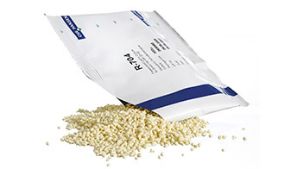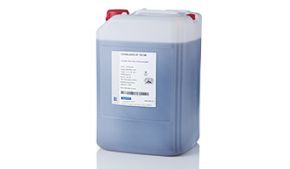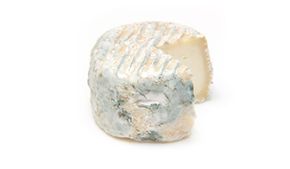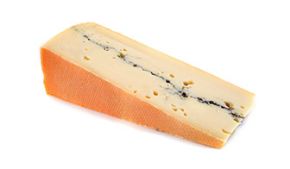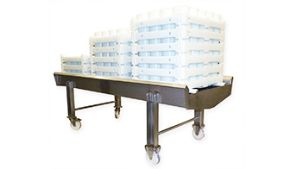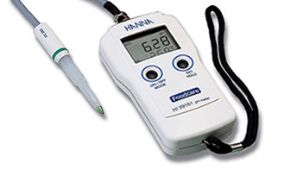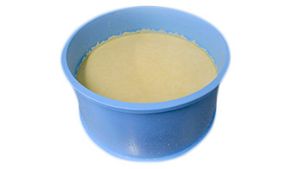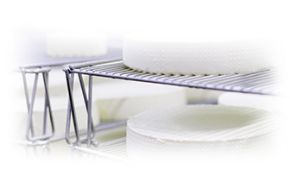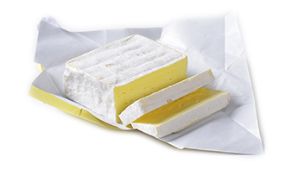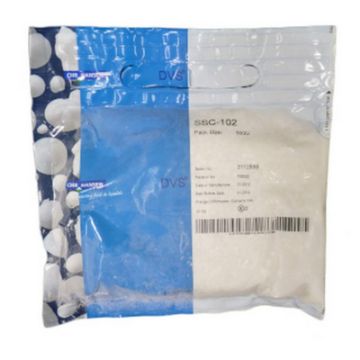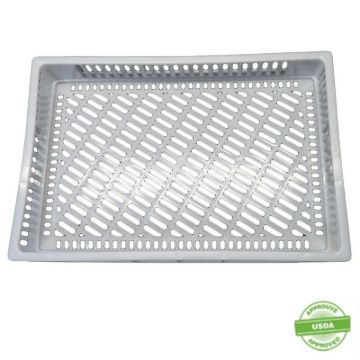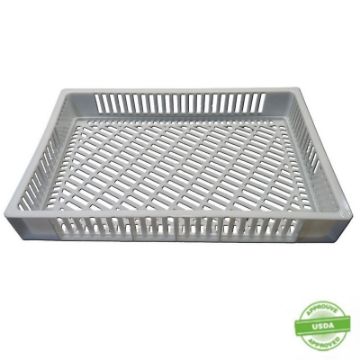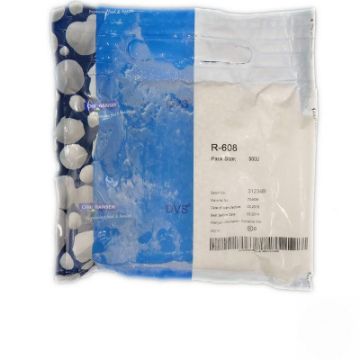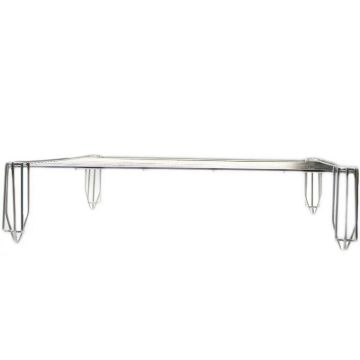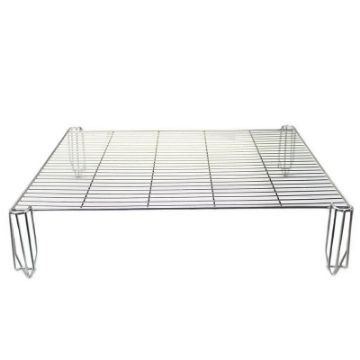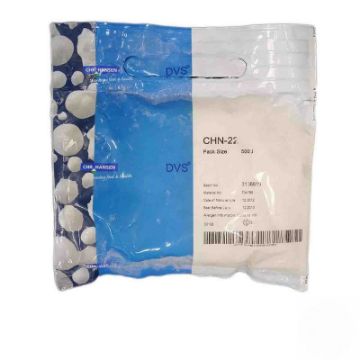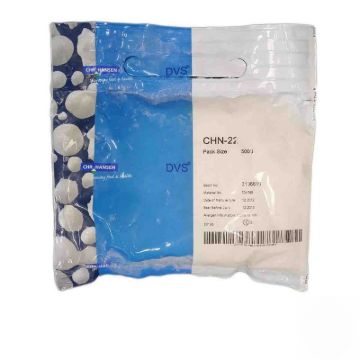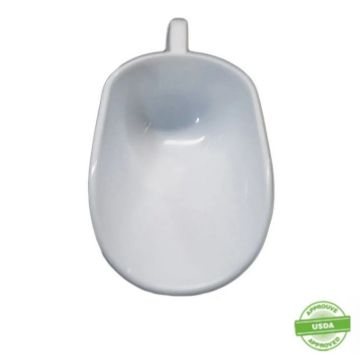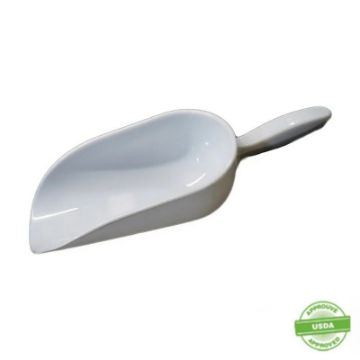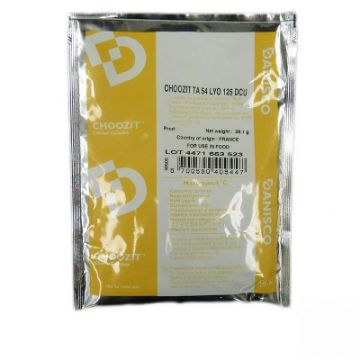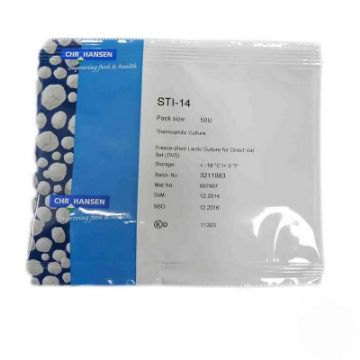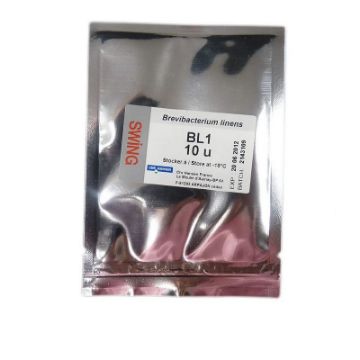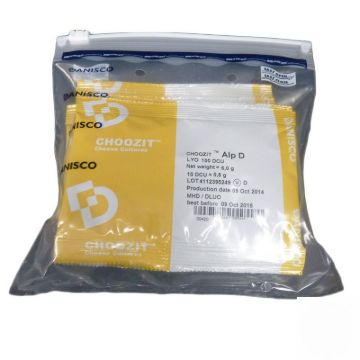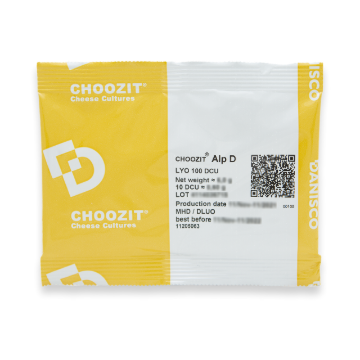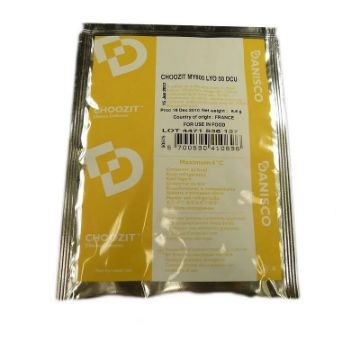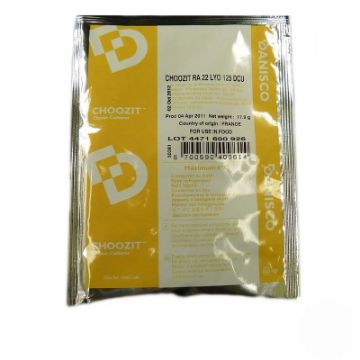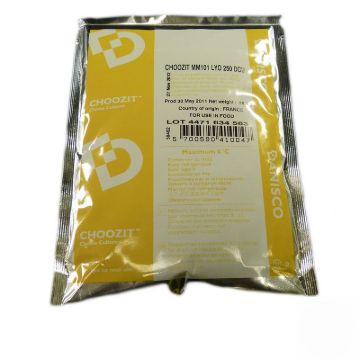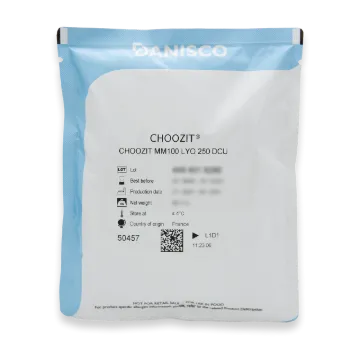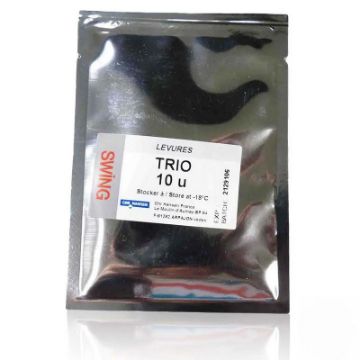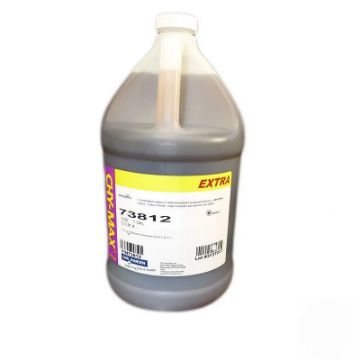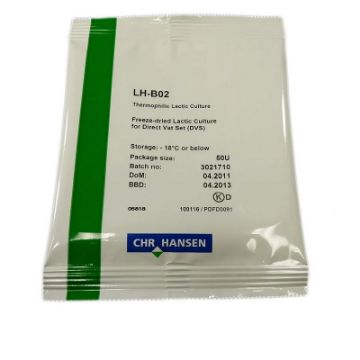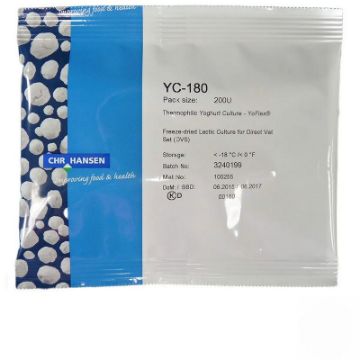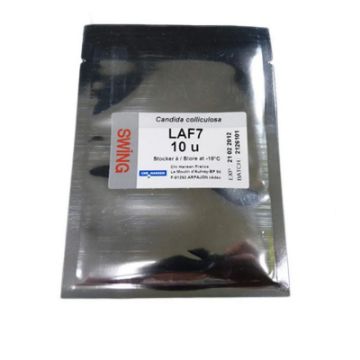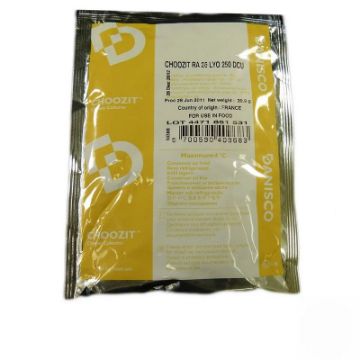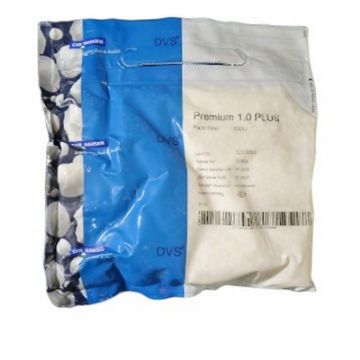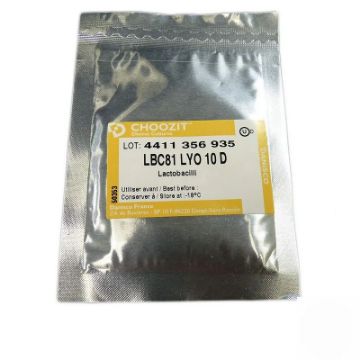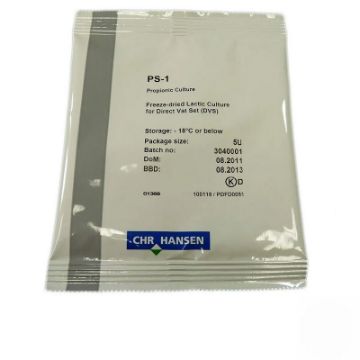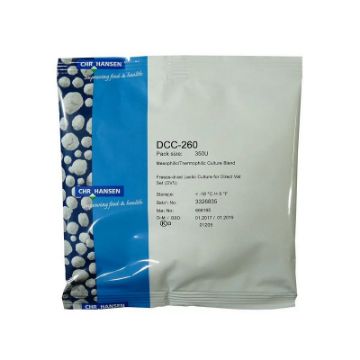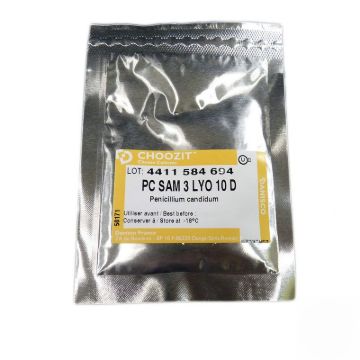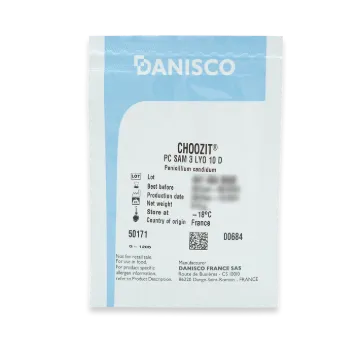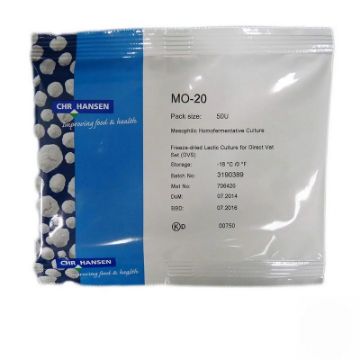Fromagex Products
From cultures to packaging, including equipment, here is our range of products.
Soft Mild 1-02 Frozen 500 u
Thermophilic lactic acid cultures.
This Chr.Hansen culture system provides thermophilic defined strains for continuous Direct Vat Set (DVS®) use by rotation.
The cultures are selected for their moderate lactic acid production and low post-acidification.
The culture is primarily applied in the production of soft cheeses where low post acidification is required, e.g. stabilized soft cheeses (Brie, Crescenza, Argentinean Port Salut) and modern Camembert types.
SSC cultures can be used alone (stabilized cheeses) or in combination with Mesophilic aromatic cultures (LD types).
Basket container 600 x 400 x 90 mm, 15 L
Perforated crate.
Designed to store delicate foodstuffs.
Perforated base and walls.
Build with side supports.
R-608 Frozen 500 u
This Chr.Hansen DVS® culture contains defined mesophilic strains and is for continous direct vat set use.
The culture provides fast lactic acid production and high phage robustness without any CO2 production (homofermentative).
The culture is primarily applied in the production of cheeses with a closed texture, e.g. Cheddar, Feta and Cottage cheese.
The culture can be applied in other fermented dairy products, in combination or not with other lactic cultures.
Stainless steel aging rack 630 x 510 mm, 25 wires, H150/130 mm
For a homogeneous rind development
The racks are assembled in stacks, leaving sufficient space for uniform ventilation of each cheese.
Racks constructed from stainless steel wire are a flexible solution that optimizes space in the factory, from storage to use.
Our wire stainless steel aging racks are used for ripening, brining and drying cheeses allowing an optimal ventilation and support of the products.
The choice of rack size should be done according to the cheese size and type.
They stack legs on legs to create shelves where the cheeses can be placed.
This modular solution will optimize the space in the room allowing an even result and an easy manipulation.
It suits well for fresh, soft and semi-soft cheeses, blue cheeses and other varieties that need to ripen or dry.
Made in #304 SS.
Assembly of the wires on the frame by food-grade spot welding.
CHN-22 Frozen 500 u
Mesophilic aromatic culture, type LD.
The culture produces flavor and CO2.
The culture can be used in the manufacture of the following products
- soft cheese with slow acidification (Lactic cheese, Camenbert, Blue Cheese)
- cheese varieties with eyes (Gouda, Edam)
- fermented milk products manufactured by separation method (Sour Cream, Fromage Frais)
- lactic butter.
38 cm scoop
For lactic-type soft cheeses with fragile and high-moisture curd
TA 54 Freeze-dried 125 DCU
Freeze-dried concentrated lactic starter for the direct vat inoculation of milk and milk bases.
STI-14 Freeze-dried 50 u
Thermophilic lactic acid culture.
The culture is primarily applied in Pasta Filata cheese types e.
g Mozzarella and Pizza cheese types.
The culture can be applied alone or in combination with other lactic acid cultures, e.g. Lactobacillus delbrueckii subsp.bulgaricus and Lactobacillus helveticus.
BL-1 Swing Freeze-dried 10 u
A selected single strain culture with origins in traditional cheese making.
Brevibacterium is one of the most important surface bacteria for its role in coloring the surface of the cheese, and producing flavor.
The culture may be applied in the production of smeared soft and semi-hard cheeses, mold soft cheese, or mixed rind cheeses.
ALP D Freeze-dried 100 DCU
Concentrated, freeze-dried culture for direct inoculation of process milk.
Defined multiple-species culture.
The quantities of inoculation indicated should be considered as guidelines.
Supplement cultures may be required depending on technology, fat content and product properties desired.
We do not accept any liability in case of undue application.
MY 800 Freeze-dried 50 DCU
Freeze-dried concentrated lactic starter for the direct vat inoculation of milk and milk bases.
RA 22 Freeze-dried 125 DCU
Freeze-dried concentrated lactic starter for the direct vat inoculation of milk and milk bases.
MM 101 Freeze-dried 250 DCU
A blend of defined strains of lactic bacteria for direct vat inoculation of milk, milk bases.
The culture is a freeze-dried powder.
LAF-TRIO Swing Freeze-dried 10 u
Selected yeast strains with origin in traditional French cheese making.
SWING® LAF TRIO is a blend of defined yeast strains.
They have been especially selected for their ablity to prevents the growth of contaminant at the surface of the cheese.
The synergetic effect from the strains inhibits contaminant, e.g. blue molds and mucor.
Yeast cultures may be used in lactic curd, soft cheeses with washed surface and Continental cheese with natural rind.
Yeast cultures may be used in lactic curd, soft cheeses with washed surface and Continental cheese with natural rind.
The culture works in different ways:
- by generation a protective film on the cheese surface
- by allowing the consumption of residual sugars
- by accelerating the curd neutralisation.
The culture works in different ways:
- by generation a protective film on the cheese surface
- by allowing the consumption of residual sugars
- by accelerating the curd neutralisation.
CHY-MAX® Extra coagulant 1 gal
CHY-MAX® Extra is a pure chymosin produced by submerged fermentation on a vegetable substrate with Aspergillus niger var.
awamori kept under contained conditions and not present in the final product.
The product contains a milk-clotting enzyme which is highly specific for kappa-casein, resulting in very good curd formation.
The general proteolitic activity also has a significant influence on the flavor and texture development of cheeses.
The active milk-coagulating enzyme is chymosin (EC 3.4.23.4).
LH-B02 Freeze-dried 50 u
Defined thermophilic lactic acid culture.
The culture enhances the overall flavor intensity of the cheese by accentuating important flavor notes.
The culture is primary applied in the production of Italian and Swiss cheese varieties.
The culture can be applied alone or in combination with other lactic cultures, e.g. Streptococcus thermophilus and Lactobacillus delbrueckii subsp.bulgaricus and LD culture.
YC-180 Freeze-dried 200 u
Thermophilic YoFlex® culture.
The culture will produce yoghurt with medium flavor, high viscosity and medium postacidification.
Suitable for cup set, stirred and drinking yoghurt.
LAF 7 Swing Freeze-dried 10 u
Selected yeast single strain with origin in traditional French cheese making.
SWING® LAF cultures are an important tool in cheese making since they may be used to affect curd neutralization, texture and flavor.
Yeasts are common in traditional raw milk cheeses but arerarely found in industrially produced cheeses.
Therefore adding selected and controlled yeast cultures to the cheese may improve quality.
The yeast culture may be used to provide a balanced flavor and medium to high levels of CO2 formation in Kefir type products.
The culture will provide flavor and medium to high CO2 formation.
RA 26 Freeze-dried 250 DCU
Lyophilized lactic ferment concentrate for the direct inoculation of milk and milk bases
PREMIUM 1.0 PLUS Frozen 500 u
Thermophilic YoFlex® culture.
The culture will produce yoghurt with mild flavor, extra high viscosity and low post-acidification.
Suitable for stirred and set yoghurt.
The culture is ideal for manufacturing of Greek yogurt.
PS-1 Freeze-dried 5 u
Selected propionic acid bacteria culture.
The culture is primarily used for the production of Swiss-type cheeses, such as Emmental, Gruyère, Greve and similar types where the typical propionic acid aroma and eye formation are desired.
The culture is normally applied in combination with lactic cultures, such as Streptococcus thermophilus , Lactobacillus helveticus, Lactobacillus delbrueckii subsp.bulgaricus and LD cultures.
The culture ferments lactate resulting in the formation of propionic and acetic acids and large amounts of carbon dioxide.
Propionic acid cultures grow slowly in milk and have a low proteolytic activity.
DCC-260 Freeze-dried 350 u
Aromatic culture blend.
The DCC culture range provides cultures with very fast acidification properties at a low inoculation rate.
The culture produces flavor and CO2.
The culture is primarily used in the manufacturing of Dutch and Continental semi-hard cheese varieties with eyes, e.g. Gouda and Edam.
SAM 3 Freeze-dried 10 D
Maturation/ ripening culture made up of Penicilium candidum spores.
Penicilium candidum is the ordinary name of Penicilium camemberti.
Direct inoculation of cheese milk.
Dilution for use in spray just before use.
We do not accept any liability in case of undue application.
MO-20 Freeze-dried 50 u
Mesophilic homofermentative culture, type O.
This culture contains specially selected strains chosen for their phage resistance and ability to produce lactic acid quickly.
This culture does not produce CO2.
The culture is primarily used in the manufacture of Continental cheese types with no eyes and short texture (e.g.Pecorino) and soft cheese specialties.

